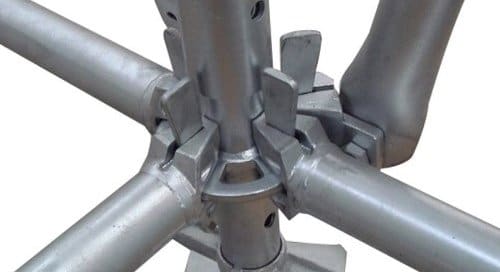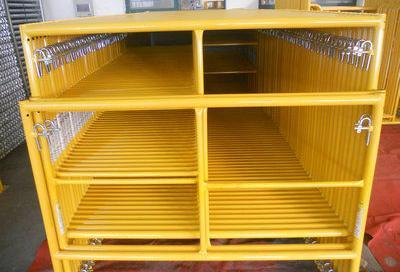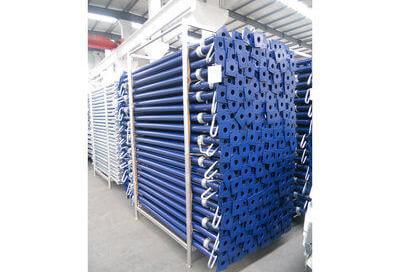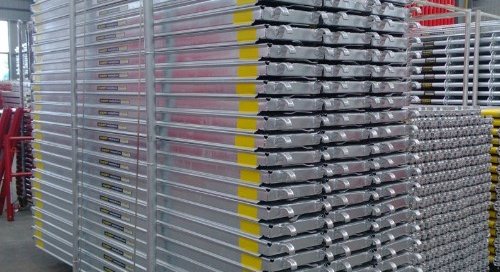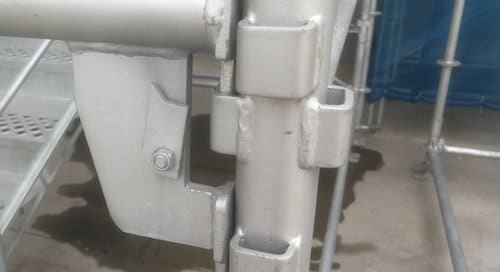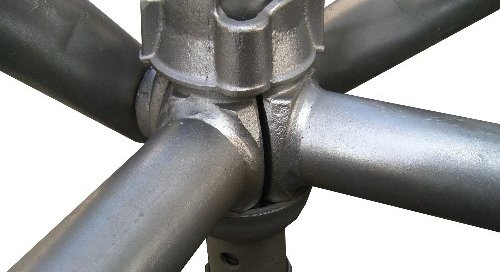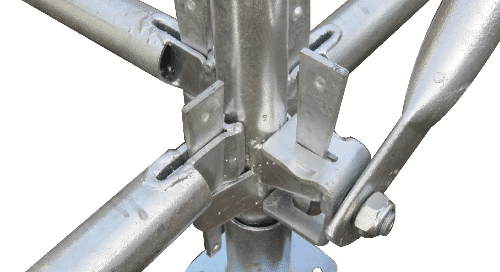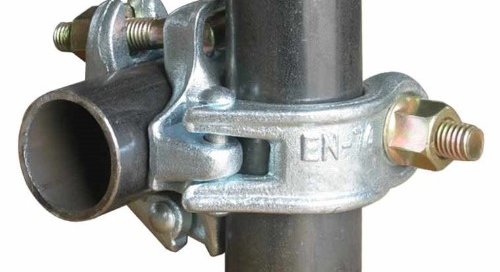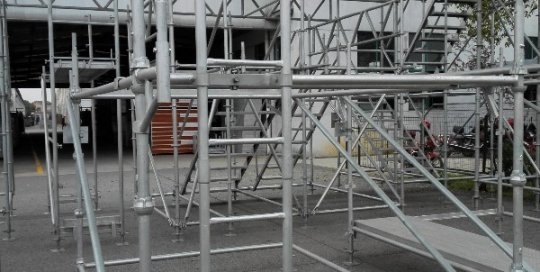Modular Scaffold
Modular scaffold, or system scaffold, is a generic term. It consists of a separate part or unit that is used to complete various supports and access works in construction.
Since the development of the scaffolding industry, the many system scaffoldings such as ringlock, frame, shoring props, haki, kwikstage, tube and couplers, have emerged.
We have no way to say which one is better, and each one has the strengths and weaknesses when they are in the construction applications. If we know their differences and features, we can design the safer, more efficient application solution by taking advantage of them.
Total Contec offers a variety of system scaffolding, and plank, stair, ladder, beam, transom, guardrail, toe board, couplers, locks, and pins.
In the years of practice, we have comprehensive knowledge of the use characteristics of various modular scaffolding, as well as requirements of materials.
We know what is the best management in the metal manufacturing industry, what are the excellent industrial workers, and how they output the consistently high-quality products in the perfect working environment.
Modular Scaffold – The Ultimate FAQ Guide
Do you know what a modular scaffold is? Have you even ever seen or encountered the term before? For newer scaffolding experts and businessmen, you should already know what it is. But do you really get what it’s trying to do?
In this guide we here at Total Contec prepared, we will be giving you the full understanding of what modular scaffold is. Not only that, but we will also provide the necessary information you need in order to pursue it.
Contents
- Ringlock
- Frame Scaffolding
- Shoring Props
- Steel Plank
- Haki
- Cuplock
- Kwikstage
- Tube and Couplers
- Steel Ladder
- Modular Scaffold – The Ultimate FAQ Guide
- What is a Modular Scaffold?
- Types of Scaffolding Systems
- Modular Scaffolding
- System Scaffolding
- What Are the Uses of Modular Scaffold?
- Major Types of Modular Scaffolding in Construction
- Cuplock Scaffolding
- Ringlock Scaffolding
- Kwikstage Scaffolding
- What is the Maximum Height of a Modular Scaffold?
- Is Modular Scaffold Similar to Tubular Scaffold?
- Comparing Tubular Scaffolding to Modular Scaffolding
- Modular Scaffold Parts
- Advantages of Modular Scaffolding
- Safety and Security
- Flexibility and Versatility
- Convenience and Ease of Use
- Are There Any Disadvantages or Drawbacks to Modular Scaffolding?
- Initial Costs and Expenses
- Complex Design Requirement
- Not Flexible and Adaptable
- What Is Prefabricated Scaffolding?
- Who Benefits the Most From Modular Scaffolding?
- How is Scaffolding Fixed/Erected to a Building?
- What is Kwikstage Scaffolding?
- Where Can You Find the Best Modular Scaffold?
What is a Modular Scaffold?
A modular scaffold is a type of system scaffolding that’s usually completed using prefabricated parts and components. Overall, this system is based on the tube coupling method or wedge, which completely enables the connection.
While this is its basis, it is not entirely similar to the tube and coupler scaffolding type – we’ll get to that in the latter part of this guide.
Types of Scaffolding Systems
There are different classifications and categorizations of scaffolding. But when it comes to the simplest and most basic ones, the types are modular and systems scaffolding.
Here are some of the things you ought to know about them.
Modular Scaffolding
This is the type of scaffolding that involves the use of various modules in order to form a base or a foundation. Modular scaffolding is seen as an effective means of scaffolding if you are working on the exterior part of a building because of this characteristic.
System Scaffolding
Systems scaffolding, on the other hand, is the type of scaffolding that makes use of fixed connections with posts that are ready for attachment and linkage. These include bearers, diagonals, and runners and have excellent linking points that can perform the necessary type of job.
As you can see, they are similar types of scaffolding and the only difference would be the terms – which point toward how they differ in the materials that are used.
What Are the Uses of Modular Scaffold?
Because of how it’s put up, you can expect to use modular scaffold in a wide range of business sectors and industries that involve construction and structural projects. The most common, however, would be:
- Oil and Gas Industry
- Construction and Structural Industry
- Marine and Maritime Industry
- Chemical Plants
- Architecture and Engineering Industry
- Renovation and Demolition
- And Many More!
Whatever industry that requires specific heights, modular scaffolding can be of dire assistance!
Major Types of Modular Scaffolding in Construction
Modular scaffolding can be seen in many different forms. What this simply means is, it can be categorized into a few groups. To help you with it, though, the major types and names in modular scaffolding include:
Cuplock Scaffolding
Cuplock scaffolding is a type of modular scaffolding that’s identified as the joining method that makes use of metal cups to interlock and conjoin standards or metal beams together. This type of scaffolding does not use nuts, bolts, and threads.
Ringlock Scaffolding
Ringlock scaffolding is a modular scaffolding category that uses rings instead of cups – this is its only difference with cuplock scaffolding.
Kwikstage Scaffolding
Last and most definitely not least is Kwikstage scaffolding. It’s usually made up of steel tubes, as well as certain types of fasteners to finish the job.
NOTE: There are a few other types of modular scaffolding in the market. These are just the more popular and sought-after ones you will encounter!
What is the Maximum Height of a Modular Scaffold?
The overall maximum height allowed as per the Occupational Safety and Health Administration of modular scaffolding would be at a height of 12 meters (39 feet). However, this can change depending on the restrictions and the certificates acquired by a company.
Is Modular Scaffold Similar to Tubular Scaffold?
No, modular scaffolding is not the same as tubular scaffold. For you to understand it further, let me give you a brief and quick description of each.
Modular scaffolding consists of a few fixed points that can accommodate bearers, diagonals, standards, and runners. Any of these independent modules or units should form a base.
Tubular scaffolding, on the other hand, otherwise known as tube and clamp or tube and coupler scaffolding is the simplest, most basic, and most traditional type of scaffolding . In this scaffolding type, the components are connected and linked together with the help and assistance of couplers and fasteners.
The major strength of modular scaffolding is its urgency and quickness in erection. On the contrary, tubular scaffolding takes pride on its adaptability and flexibility to the working environment.
Comparing Tubular Scaffolding to Modular Scaffolding
Before we talk about their indifferences, let us first discuss where they are similar.
Both modular and tubular scaffolding employ the use of tubes and points to be able to build and erect the tower. Furthermore, these scaffolding types would need careful and thorough examination of the loading capacity.
Here’s a brief table that would help you understand their differences more:
| Scaffolding Characteristic | Modular | Tubular |
| Cost | Costlier and more expensive than tubular scaffolding. | More affordable and easier to acquire. |
| Flexibility | Requires initial sizing – not openly flexible and adaptable. | Flexible in almost all types of scenarios and business uses. |
| Design Requirement | Requires complex design and structure ideologies. | Does not need complexity and experience when it comes to designing. |
| Timing | Super-fast and easy to set up and use. | Slow and labor-intensive to set up. |
| Safety and Security | Erection and working principles are both extremely safe and secure. | Safe and secure, but not as safe as modular scaffolding. |
| Industry | Primary use would be in the oil and gas industry, as well as the civil engineering industry. | Primary use would be in the residential and commercial industry. |
These are the points of difference of these two (2) types of scaffolding.
Modular Scaffold Parts
The parts and components of modular scaffolds vary depending on what the type of project is, the height that is to be achieved, and of course, the materials needed.
Nevertheless, the general parts of modular scaffolding include:
- Standards
- Couplers
- Base Plates (Base Jacks)
- Ledgers (Horizontal Braces)
- Diagonal Braces
- Toe Boards
- Staircases
- And Others
NOTE: Some are industry-specific and project-specific.
Advantages of Modular Scaffolding
Modular scaffolding employs a few benefits and advantages. You might be surprised at how well it has performed. Nevertheless, the following are considered the primary benefits and advantages of modular scaffolding:
Safety and Security
This actually, is one of the major advantages and benefits of using a modular scaffold. They’re built safely and securely with an interlocking system that helps to prevent the likelihood of failure, property damage, and of course – injury.
All components in modular scaffolding is built for the purpose of protection and security!
Flexibility and Versatility
In terms of customization, modular scaffolding is adaptable and versatile. Tubular scaffolding is better in terms of on-the-spot adaptability, but modular scaffolding won’t fail you when it comes to how flexibly you can customize and work on it.
Convenience and Ease of Use
Of course, the benefit that many people want would be how convenient modular scaffolding is. Modular scaffolding is a convenient way for both workers and owners. It is convenient for owners because the working height, space, and overall room is workable, versus other types of scaffolding where there are limitations and restrictions in space.
NOTE: These are just some of the major benefits and advantages of using modular scaffolding. Of course, there are other pros and benefits to it, but you’ll be able to figure it out when you start employing the use of the scaffold itself.
Are There Any Disadvantages or Drawbacks to Modular Scaffolding?
Akin to the advantages, you’ll also be able to find cons or drawbacks to using modular scaffolding. These drawbacks include, but are not limited to:
Initial Costs and Expenses
Of course, the con or disadvantage that we all hate – cost. Because of all the properties and characteristics it possesses, you need to expect paying a premium for it. It’s not like it’s extremely well and efficient without paying the price, right?
Complex Design Requirement
Another would be the complexity and requirement of its overall design. The modular scaffolding system isn’t for the faint of heart – it is something that requires constant checking and modifications in order to attain the wanted and needed design for it.
Not Flexible and Adaptable
And of course, compared to the age-old scaffolding, it is not flexible. Since the materials are going to be pre-made or pre-fabricated, there needs to be a complete initial check and assessment of the parts and components to see if it will fit well to the height and size of the scaffold.
As you may have noticed, all these are overpowered by the pros and advantages, right? So, you shouldn’t worry about these drawbacks at all.
What Is Prefabricated Scaffolding?
Pre-fabricated scaffolding, from its term alone, is a type of modular scaffolding where the components are already pre-made or pre-fabricated. It is labelled and termed as “pre-fabricated” because all workers need to do is to integrate all components together in order to assemble the scaffold.
There’ll be no more drilling, cutting, sawing, subtracting, or adding of material – they’re already pre-made or pre-fabricated.
Who Benefits the Most From Modular Scaffolding?
Many professionals and experts have benefited from using modular scaffolding. The most professions that did benefit from it include, but are not limited to:
- Carpenters
- Architects
- Engineers
- Bricklayers and Construction Workers
- City Planners
- Private and Public Inspectors
- Masons
- And Many More!
Other than these, though, many other professionals and experts benefit from modular scaffolding.
How is Scaffolding Fixed/Erected to a Building?
For suspended scaffolding, a type of the primary categories of scaffolding, it is the type where the scaffolding is affixed, resting, and latching onto the building instead of being assembled from the ground.
On the contrary, supported scaffolding can also be fixed to a building by a means of an integrated ground-level attachment.
There are many different ways of how companies affix and install scaffolding onto buildings, but the most common way of erecting it would be by doing the following procedure:
- The base or foundation of the scaffolding is made and installed.
- For the case of suspended scaffolding, the attachment or the ties are pre-positioned.
- Once done, the standards and ledgers are going to be positioned as the receiving end.
- For the case of suspended scaffolding, the ties need to be double-checked and re-assessed to ensure that it wouldn’t fall off or break down.
- After that, the scaffolding structure is started for the creation of the first layer, and then the second layer, and so forth.
NOTE: For each layer, there needs to be some type of security function or feature to ensure that each level is independent. Just because they’re towers, doesn’t mean they’ll fall off when a single layer or level does.
What is Kwikstage Scaffolding?
Kwikstage scaffolding is one of the types of modular scaffolding that’s identified as having a “wedge fixing” for all accesses to the scaffold requirements. These fixings help out in transforming the ledger via fast means of erection without suffering loosened parts.
FUN FACT: The very first Kwikstage scaffolding systems have been created and innovated by RMD Kwikform in 1948. Since then, Kwikstage scaffolding is identified as one of the types of modular scaffolding because of how effective and efficient it is.
Where Can You Find the Best Modular Scaffold?
In the entire country, no other modular scaffold manufacturing company is as excellent as us here at Total Contec. We’re considered by many as their one-stop manufacturer for all different types of modular and system scaffolding they need.
We are experts in Kwikstage, tube and couple, ringlock, cuplock, and even HAKI scaffolding. Not only that, but you can also bank and count on us if you ever find yourself in need of PPE or personal protective equipment for your projects!
Reach out to us and we’ll be more than happy to help you with all your modular scaffolding needs!
Not sure of what you need to get? Consult with us and we will help you identify what exactly it is that you need! We have experts ranging from sets of engineers, pre-fabrication professionals, and even experienced construction experts to help you!

